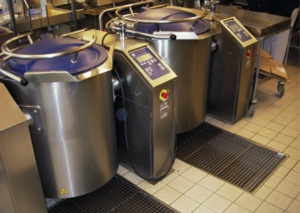Can the drain take the strain?

Internal drainage is receiving more attention from regulatory authorities, driving the need for higher standards — as Chris Ricketts explains.
Internal drainage is rarely even close to the top of a contractor’s list of critical products on a project. Time constraints mean that care is taken on what is regarded as significant items, with lower involvement decisions often reduced to a repeat of previous specifications. The result is that internal drainage is often an afterthought, with many contractors going to what they know, specifying a similar product from job to job.
However, eliminating risk involving the use of internal surface-drainage control systems is now high up the agenda for regulatory authorities. As a result, the guidelines for internal drainage are changing all the time, and it is vitally important that those specifying and fitting drainage products keep up-to-speed with developments.
Unbeknown to many contractors and specifiers the BS EN 1433 harmonised European standard, which covers drainage channels for vehicular and pedestrian areas, is also relevant internally. As this standard is harmonised, products that are offered to the European Community will be CE marked. Although CE marking is not yet mandatory in the UK, it will be when the Construction Products Regulations come into force in 2013.
The advantage of this regulatory tightening is clear. Commercial kitchens and food-service environments are what is termed extremely hostile. They are hot, often have wet floors and are also very busy. This creates a hazardous health-and-safety environment which specifiers and contractors cannot ignore as it could certainly be argued that both have a duty of care to ensure that the very highest standard of equipment is installed.
Risk can be mitigated by adhering to the required standards, but this is easier said than done. The material of choice in kitchens and food-service environments is stainless steel which is hygienic, corrosion and chemical resistant and durable. However, there are many suppliers of steel drainage across the Eurozone, with few manufacturing products that are either designed or produced to the relevant standards. This situation is exacerbated by a presumption of fitness for purpose, rather than an in-depth study of the different products available, on the part of specifiers and contractors.
For example, ACO Building Drainage’s linear drainage systems have been designed to meet all the necessary standards, which includes the vigorous demands of load bearing, watertightness and durability — but this remains the exception rather than the rule in the UK at the present time.
The standards for internal drainage matter because they allow specifiers and contractors to make informed choices in relation to an application by detailing key performance requirements from the product.

The first key criteria is load-bearing capacity, which for internal drainage means the ability to cope with high point loads imposed by heavy kitchen equipment being moved over it. Issues such as distorted gratings, though notionally minor, are a hazard — particularly with mobile kitchen equipment.
A second criterion is durability. The catastrophic failure of a drainage system, which results in the need to replace the equipment, may on the face of it seem like an inexpensive business with a drainage gully having a unit cost of circa £200. However, replacing a gully requires the entire kitchen operation to be closed. Once the cost of labour is taken into account, the cost could be in the region of £2000. The true cost, of course, should also include the lost business.
Fundamental to the success of any internal drainage system is the removal of surface water to prevent slips and trips and also to ensure that there is no build-up of bacteria. The final criteria, therefore, is water tightness, which is a far more serious issue internally in comparison to external drainage. Increasingly, commercial kitchens are being housed on the upper floors of buildings with expensive IT equipment or plant machinery below them. I am personally aware of one leaking floor in a commercial building in London resulting in more than £1 million of damage to floors below.
The forthcoming Construction Products Directive, due in 2013, will make CE marking mandatory for products that fall under the remit of harmonised standards. Whilst manufacturers that sell non-CE marked products will be committing an offence, specifiers and subcontractors must also take care. Whilst it is not yet obligatory to procure on the basis of the standards, it is certainly part of a specifier or contractor’s responsibility to ensure that the best products are fitted which comply with those standards.
Chris Ricketts is product group manager with BSS Industrial.








